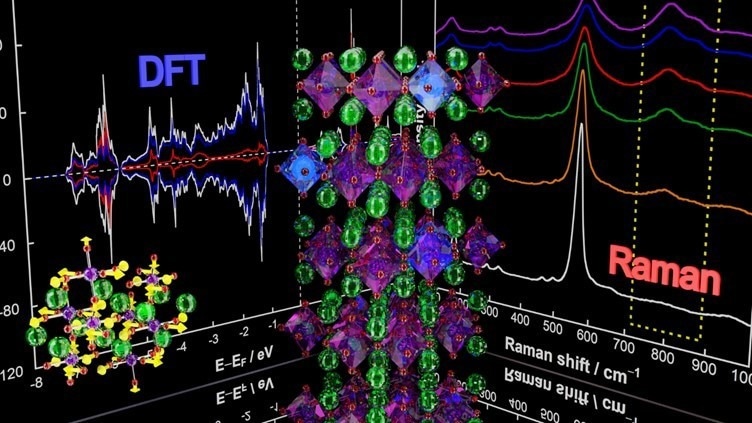Cities with little tree cover are substantially hotter than their surroundings. This is because absorption of near-infrared (NIR) radiation in sunlight causes the “urban heat island” effect. As a result, NIR-reflective pigments that are able to mitigate such heating effects are highly desirable.
 Structure and electronic state analyses of layered perovskites using a combined experimental and theoretical approach. In a new study, researchers from Nagoya Institute of Technology, Japan use a combination of experimental and theoretical approaches to understand the optical, electronic, and magnetic properties of complex solids of layered perovskite compounds, providing valuable insights. The approach is extendable to a wide range of functionalized crystalline ceramic compounds. Image Credit: Ryohei Oka from Nagoya Institute of Technology, Japan
Structure and electronic state analyses of layered perovskites using a combined experimental and theoretical approach. In a new study, researchers from Nagoya Institute of Technology, Japan use a combination of experimental and theoretical approaches to understand the optical, electronic, and magnetic properties of complex solids of layered perovskite compounds, providing valuable insights. The approach is extendable to a wide range of functionalized crystalline ceramic compounds. Image Credit: Ryohei Oka from Nagoya Institute of Technology, Japan
Functional inorganic pigments, in particular, are an appealing possibility in this regard. Dr. Ryohei Oka and his colleague from Nagoya Institute of Technology in Japan have proved that layered perovskite ceramic compounds of the type A2BO4 are suitable for reflecting NIR.
In prior work, Dr. Oka revealed that new perovskites, such as titanium-added calcium manganese oxide [Ca2(Mn,Ti)O4] ceramics, are significantly better at reflecting NIR radiation than commercially available black pigments. The method by which Ca2(Mn,Ti)O4 performs this extraordinary accomplishment, however, is unclear.
Dr. Oka and his colleague, Dr. Tomokatsu Hayakawa, used a mix of established theoretical and experimental methodologies to evaluate the variables leading to Ca2(Mn,Ti)O4’s NIR reflectivity in a recent work published in Inorganic Chemistry. This work was published on May 2nd, 2022.
The researchers effectively extracted missing data regarding the crystal structure and electronic states of Ca2(Mn,Ti)O4 using X-Ray diffraction (XRD) and Raman spectroscopy in conjunction with a computational approach known as “density functional theory” (DFT).
Few studies so far have conducted Raman spectroscopy of Ca2(Mn,Ti)O4. Furthermore, they have not provided any detail of its vibrational modes. However, information about its electronic states and vibrational modes is crucial to understand how these perovskites turn out to be such great NIR reflectors.
Dr. Ryohei Oka, Assistant Professor, Department of Life Science and Applied Chemistry, Nagoya Institute of Technology
The researchers investigated the crystal structure of calcium manganese oxide (Ca2MnO4) and the structural alterations that occurred when Ti impurities were added. Furthermore, scientists discovered how Ti impurities change the chemical bonds inside the perovskite. They discovered that, when compared to Ca2MnO4, Ca2(Mn,Ti)O4 had an extra Raman peak, which was most likely generated by the Ti impurities activating a “silent mode.”
The XRD patterns of Ca2MnO4 and Ca2(Mn,Ti)O4 were, nevertheless, similar. This was attributed to the Ti–Ti correlation at a specific distance by the couple.
Another feature of their research was the remarkable consistency between DFT computational findings and experimental data. The energy gaps calculated by the pair from the three Ca2(Mn,Ti)O4 models agreed with each other and with the experimental result. Furthermore, the finding was independent of Ti-substitution or crystal location.
Furthermore, the calculations indicated that the increased NIR reflectivity caused by Ti ions was due to a decrease in “density of states” (the number of electronic states per unit volume per unit energy) around the Fermi level (the highest energy level an electron can fill at absolute zero temperature).
These discoveries take researchers a step closer to understanding the thermal shielding ability of perovskite ceramics. The optimal mix of experimental and theoretical methodologies presented in this work gives a comprehensive formula for understanding the structure and behavior of not just A2BO4 type ceramics but a wide variety of complicated perovskite ceramics.
This combinational approach is applicable to a wide range of functionalized crystalline ceramics to understand their optical, electronic, and magnetic properties in a much better way with more reliable structural models obtained computationally.
Dr. Ryohei Oka, Assistant Professor, Department of Life Science and Applied Chemistry, Nagoya Institute of Technology
If inorganic pigments become more widely used as improved thermal coverings for urban structures, a thorough knowledge of the increased NIR reflection process will be tremendously advantageous.
Journal Reference:
Oka, R. and Hayakawa, T. (2022) Raman Spectroscopic Investigation and Electronic State Calculation for Ca2(Mn,Ti)O4 Black Pigments with High Near-Infrared (NIR) Reflectivity. Inorganic Chemistry. doi.org/10.1021/acs.inorgchem.2c00254.